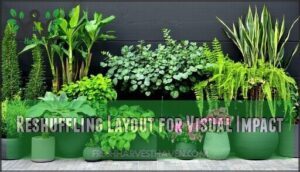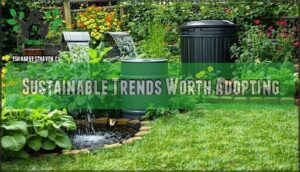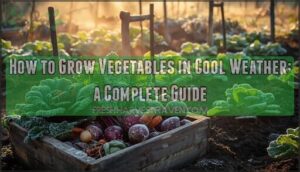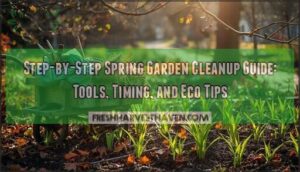This site is supported by our readers. We may earn a commission, at no cost to you, if you purchase through links.
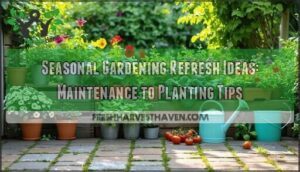
Whether you’re battling weeds that spread faster than you can pull them, containers that look tired and leggy, or bare spots begging for new life, these seasonal gardening refresh ideas will help you work smarter, not harder.
From timing your second plantings to adopting water-wise techniques that actually save you weekend hours, you’ll discover how small adjustments now create gardens that thrive when others fade.
Table Of Contents
Key Takeaways
- Strategic mid-season maintenance like preventative weeding, deadheading, and mulching keeps gardens productive through fall when most yards start to fade.
- Timing second plantings of fast-maturing crops (radishes in 22-30 days, arugula in 21-28 days) and planting spring bulbs now extends harvests and sets up early blooms for next year.
- Switching to drought-tolerant plants and water-wise techniques can slash outdoor water use by 50-75% while native plantings support up to 3.2 times more wildlife than non-natives.
- Container gardens stay vibrant year-round by swapping in cool-season bloomers like pansies and ornamental kale as temperatures drop, rather than starting from scratch each season.
Essential Mid-Season Garden Maintenance Tasks
By mid-season, your garden’s probably showing signs of wear—overgrown weeds, faded blooms, and plants that could use some backup.
A few simple maintenance tasks can bring everything back to life and keep your garden producing through the rest of the season. Here’s what to tackle first.
Weeding Before Seeds Spread
If you let weeds go to seed now, you’re basically planting next summer’s headache—so grab your tools and tackle them while they’re still manageable. Preventative weeding saves hours down the line and keeps your perennial borders from turning into a jungle. Here’s your game plan:
- Pull weeds after rain when soil’s loose
- Identify seed heads—yank those first
- Use a hoe for shallow-rooted invaders
- Bag seeded weeds separately (don’t compost them!)
- Mulch bare spots to block new sprouts
Stay consistent with garden maintenance, and summer gardening becomes way more enjoyable.
Deadheading for Continuous Blooms
Once you’ve cleared out the weeds, snipping off spent blooms keeps your plants pumping out fresh flowers instead of pouring energy into seed production. Deadheading flowers encourages reblooming and extends the bloom period while improving overall bloom appearance.
Focus on perennials and repeat-blooming annuals—they’ll reward you with fresh flower blooms and better plant vigor throughout your summer gardening season, preventing seed formation that signals "time to quit.
Mulching to Retain Moisture
After you’ve tidied up those spent blooms, a fresh layer of mulch acts like a cool drink for your soil, locking in moisture and cutting down on how often you’ll need to haul out the hose.
Aim for two to three inches of organic mulches like shredded bark or compost—they’ll keep soil temperature steady, suppress weeds, and break down over time to feed your plants while you tackle other garden tasks.
Staking Heavy Plants and Vines
When your tomatoes start leaning like they’ve had a long day in the sun, or your squash vines sprawl across the path, it’s time to give them a little backbone with stakes or trellises. Proper plant assistance keeps fruit off the ground and prevents branches from snapping under their own weight—here’s what works:
- Tomatoes and beans love sturdy cages or vertical stakes for solid weight distribution
- Cucumbers and squash thrive when you guide their vines upward, saving garden real estate
- Choose bamboo, metal, or wooden stakes based on your plant’s heft and growing season
- Weave stems gently through aids to boost air circulation and dodge disease
Staking transforms your vegetable garden into a vertical powerhouse.
Refresh Your Container Gardens Seasonally
Container gardens don’t have to look the same all year—they’re actually perfect for seasonal makeovers. A few simple changes can transform tired summer pots into fresh fall displays that keep your patio looking vibrant.
Here’s how to give your containers a seasonal refresh without starting from scratch.
Adding Bold Foliage and Texture
Sometimes the biggest visual impact comes not from flowers, but from leaves that command attention with their size, shape, or color. Think about incorporating dark foliage like purple fountain grass or deep burgundy coleus alongside chartreuse sweet potato vine for dramatic foliage color contrast. Playing up texture through bold leaf shapes creates garden aesthetics that pop.
These textural plant combinations give your containers depth and interest even between bloom cycles.
| Plant Type | Texture Contribution |
|---|---|
| Ornamental Grasses | Movement, fine texture |
| Elephant Ears | Bold, architectural forms |
| Silver Foliage Accents | Softness, light reflection |
Incorporating Cool-Season Bloomers
As summer heat fades and nights start to cool, you’ll want to swap those heat-loving annuals for bloomers that actually thrive when temperatures dip. Cool-season flowers like pansies, violas, and ornamental kale deliver winter color options, while frost-tolerant varieties keep your fall container design ideas alive.
Try these for extending the bloom season:
- Pansies – cheerful faces through frost
- Ornamental Cabbage – sculptural texture
- Snapdragons – vertical interest
- Dianthus – spicy fragrance
- Calendula – golden fall gardening warmth
Plant early spring blooms now for seasonal interest that carries you forward.
Reshuffling Layout for Visual Impact
Once your cool-season bloomers are settled in, it’s time to play designer and rearrange your containers like you’re solving a puzzle—taller plants in back, spillers at the edge, and that statement piece right where it catches the eye.
This reshuffling container layout technique creates textural interest through height and texture variations while establishing a strong focal point creation.
Try color palette shifts for seasonal accents, or experiment with pathway redesign using garden design techniques that improve garden aesthetics without starting from scratch.
Changing Underplanting for Fall Interest
Your containers don’t need a complete overhaul—swapping out underplantings gives you instant fall appeal without disturbing those knockout centerpieces you’ve already perfected.
Try tucking cool-season bloomers like ornamental kale or violas beneath shrubs for seasonal color, or add texture contrast with wispy grasses and trailing sedums.
Layer in spring bulb combinations now for winter interest that’ll surprise you come March—updating container gardens becomes a year-round conversation, not just a one-time setup.
Smart Planting for Extended Harvests
You don’t have to wait until spring to fill those empty spots in your garden. Smart planting right now means you’ll keep harvesting fresh produce well into fall and set yourself up for early blooms next year.
Here’s how to stretch your growing season and make the most of every square foot.
Late-Season Vegetable Varieties
You can still squeeze in a productive crop before frost arrives by choosing rapid-maturation varieties. Radishes reach maturity in as little as 22 to 30 days, while arugula is harvest-ready in 21 to 28 days. Bush beans like ‘Slenderette’ need around 55 days, and beets mature in 55 to 70 days.
Calculate your fall planting dates by counting backward from your first frost date, then add 14 days for slower fall weather growth and another 14 for frost-sensitive crops. This simple math makes succession planting and extending harvests straightforward, letting you enjoy fresh late-season veggies well into autumn.
Cool-Weather Crops for Fall
When temperatures drop, hardy leafy greens and brassica planting become your best friends. Kale and spinach thrive at 60°F-65°F and tolerate serious cold—kale even tastes sweeter after frost. Mustard greens and collards deliver high yields (8-10 tons per acre) and improve with chilly weather.
Timing matters: August-planted kale harvests in 28 days, while late September plantings need 41 days and yield just 28% as much. Radishes tolerate cold beautifully and can go in four weeks before frost.
Spring-Flowering Bulbs for Next Year
While you’re tucking in those cool-season crops, fall is actually the perfect time to plant bulbs that’ll reward you with a riot of color next spring. Tulips, daffodils, and crocuses need 12-16 weeks of cold dormancy to bloom properly, so October planting hits the sweet spot.
Plant bulbs at three times their height—a 2-inch bulb goes 6 inches deep—in well-draining soil enriched with compost to prevent rot and fuel those early spring flowers.
Expanding With Drought-Tolerant Plants
If water conservation matters to you—or your water bill does—xeriscaping and drought-tolerant plants are gaining serious ground in 2025 gardens for good reason. These water-wise beauties need less fussing once established, making them perfect for expanding your garden without ramping up maintenance:
- Succulents and sedum for low groundcover with striking foliage
- Native alternatives that thrive in your local climate
- Soil amendments like compost to boost water retention
- Proper planting techniques promote deep root development
You’ll save water, lower bills, and still enjoy a lush, resilient landscape.
Soil Health and Disease Prevention
Healthy soil is your garden’s best defense against disease, and it all starts with what you feed the ground. When plants have strong roots and good airflow, they’re much better at fighting off fungi, rot, and pests.
Here’s how to keep your soil in top shape and stop problems before they spread.
Adding Compost and Organic Matter
Think of compost as a vitamin boost for tired soil—it replenishes nutrients that plants have pulled out all season long, improves drainage in heavy clay, and helps sandy soil hold onto moisture like a sponge.
Spread a two- to three-inch layer around your plants each fall or spring, mixing in organic material like aged manure or leaf mold to jumpstart nutrient cycling and support long-term soil health.
Improving Air Circulation
Good airflow between plants acts like an invisible shield, keeping fungal spores from settling on damp leaves and giving moisture a quick escape route before trouble starts.
Space plants according to their mature width, prune overcrowded branches to open up the canopy, and use trellis systems to lift sprawling vines off the ground—these pruning techniques directly boost plant health and disease prevention while encouraging vigorous plant growth throughout the season.
Removing Diseased Vegetation Promptly
Spotting a yellow leaf, a brown patch, or a wilting stem early—before the problem spreads—can save you weeks of frustration and protect the plants you’ve worked so hard to nurture.
Snip off any diseased foliage with clean shears, bag it up, and toss it in the trash—not your compost pile—to stop pathogens from hitching a ride back into your garden.
Sanitize your tools with rubbing alcohol between cuts, especially when moving from sick plants to healthy ones, keeping disease identification and prompt removal at the heart of your summer gardening routine.
Sustainable Trends Worth Adopting
Gardening is getting greener, and that’s not just about the plants. You can make your garden more sustainable without sacrificing beauty or productivity.
Here are four trends that’ll save water, support local ecosystems, and lighten your environmental footprint.
Water-Wise and Xeriscaping Techniques
Xeriscaping isn’t just trendy—it slashes outdoor water use by 50% to 75% while supporting native plants and pollinators. Here’s how to embrace water conservation this summer:
- Install smart irrigation systems with soil moisture sensors for precision plant care
- Group drought-tolerant species together for efficient garden design
- Apply organic mulch to boost soil health and retain summer moisture
- Replace thirsty lawns with native groundcovers requiring minimal weed control
- Use soaker hoses delivering 90% water efficiency directly to roots
Fort Collins saved 180 million gallons in 2024 through water-wise landscapes—proof that sustainable garden design works.
Fort Collins saved 180 million gallons in 2024 with water-wise landscapes, proving sustainable garden design delivers real results
Front Yard Food Gardens
Turning your front lawn into a productive food garden can save you roughly $160 a year while cutting down on mowing time and fertilizer bills.
Before you plant tomatoes, squash, cucumbers, or beans, check your HOA rules—some neighborhoods restrict front-yard veggie patches.
Design with curb appeal in mind by mixing edible landscaping with flowers, and stay on top of pest control to keep your harvest healthy.
Native and Naturalized Plantings
Native plants are the backbone of wildlife support, hosting up to 3.2 times more herbivore species and four times the biomass compared to non-natives. By planting pollinator-friendly plants and late-blooming perennials in your perennial borders, you’ll boost local biodiversity while improving water conservation and soil health. Here’s what makes native and naturalized plantings worth it:
- Cut irrigation needs by 55–70% in drought-prone areas
- Reduce fertilizer use by 25–50% annually
- Support 300+ bird species with essential nesting habitat
- Lower maintenance time by 20–30% each season
- Build climate resilience by absorbing over 48 pounds of CO₂ per mature tree yearly
Choose native perennials adapted to your region’s rainfall patterns for the best results.
Battery-Powered Garden Equipment
Switching to battery-powered tools isn’t just about quieter mornings—it’s about slashing your garden’s carbon footprint while getting the same (or better) performance you’d expect from gas guzzlers.
Modern battery equipment cost has decreased considerably, with battery life expectancy now reaching 3–5 years of reliable summer gardening tasks.
You’ll enjoy noise reduction during maintaining a garden sessions, cut equipment maintenance by half, and reduce environmental impact—all while tackling your summer plant care tips with zero emissions.
Frequently Asked Questions (FAQs)
How often should I fertilize during seasonal transitions?
Fertilizing during seasonal transitions depends on your soil conditions and what you’re growing. Most gardens benefit from feeding every 4–6 weeks, but run a soil test first to avoid overloading nutrient content.
Cool-season crops need less nitrogen than summer vegetables, so adjust fertilizer types accordingly. Adding compost during soil preparation also reduces how often you’ll need synthetic options.
Whats the best time to prune perennials?
Timing depends on bloom schedule. Prune early bloomers right after flowering ends, while late-blooming perennials get trimmed in late winter or early spring during dormancy.
Deadheading flowers throughout the season keeps reblooming varieties producing fresh growth and improves plant health.
How do I protect plants from early frost?
Cover tender plants with frost blankets or cold frames when temperatures dip below 32°F. Water your garden before frost hits—moist soil retains heat better.
Check your plant hardiness zones to know which cool-weather crops can withstand the chill and which need protection.
When should I divide overcrowded perennials?
Divide perennials in early spring or fall when they’re not actively flowering.
Look for crowded clumps with bare spots in the center—that’s your cue. Dig carefully, inspect roots for health, then replant divisions with proper spacing and water them well.
How can I attract pollinators to my garden?
Plant pollinator-friendly plants like bee balm and Agastache Pink Pearl in your summer garden.
Add shallow water sources, create nesting habitats with native plants, and skip pesticides to keep butterfly gardens thriving year-round.
Conclusion
Your garden will literally transform overnight if you commit to these seasonal gardening refresh ideas—okay, maybe not overnight, but the difference you’ll see in just a few weeks will surprise you.
The real secret isn’t doing everything at once; it’s choosing two or three strategies that fit your schedule and sticking with them. Mulch those beds, tuck in some cool-season crops, and watch your garden bounce back with energy when neighboring yards start to fade.
Small, smart moves now mean big rewards later.
- https://petruslandscape.com/gardening-statistics-in-2025/
- https://165357.fs1.hubspotusercontent-na1.net/hubfs/165357/2025%20Garden%20Trends%20Report.pdf
- https://www.gardencentermag.com/news/gardening-trends-2025-economic-uncertainty-garden-media-group-spring-analysis/
- https://www.ocalagazette.com/lawn-and-landscape-projects-with-the-greatest-roi/
- https://fromsoiltosoul.ca/the-top-2025-gardening-trends-for-backyard-gardeners-according-to-experts/



